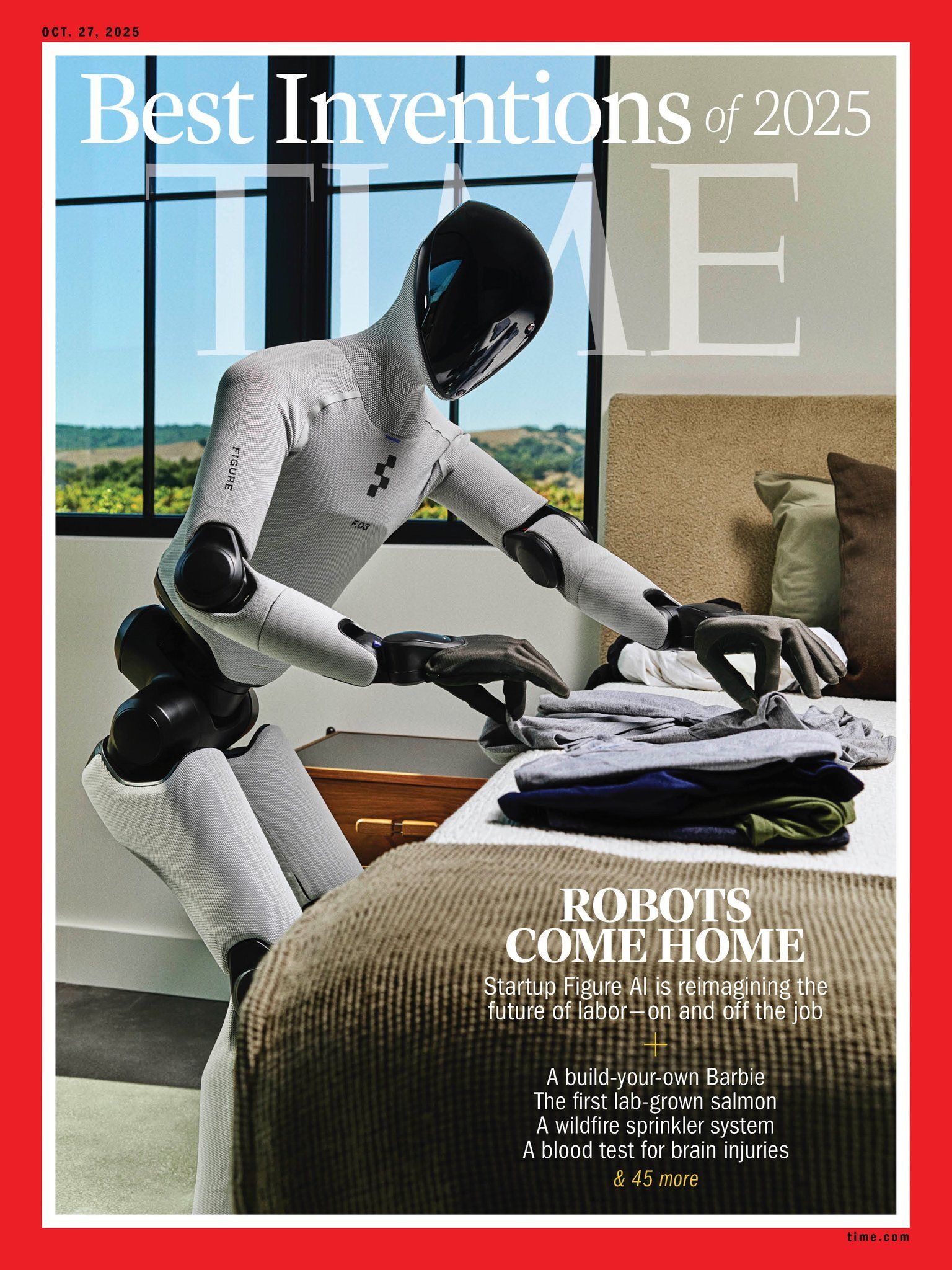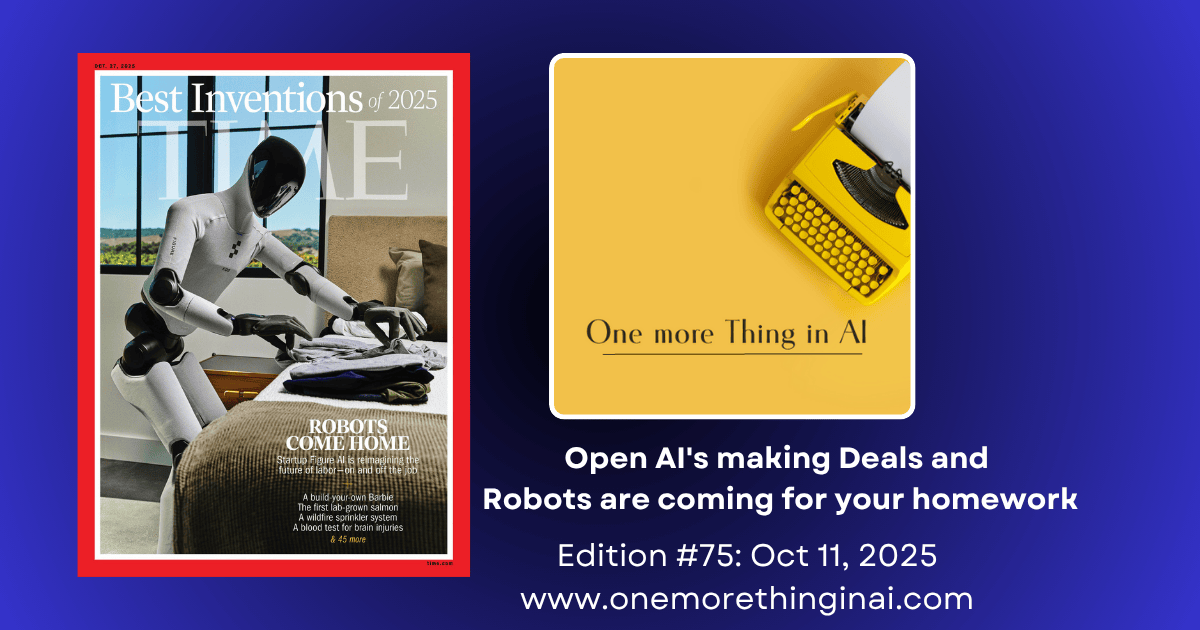Very little is needed to make a happy life; it is all within yourself, in your way of thinking.
Date: 11-Oct-2025
Hey {{first_name | AI enthusiast}},
And just when you think you’ve seen it all…there’s always One More Thing in AI.
In this edition:
Also: introducing you to our podcast edition for those of you who want to listen to it on the go. Check it out on your favorite platforms:
I hope you enjoy this edition!
Best,
Renjit
PS: If you want to check out how to implement AI in your Insurance broking business and get more revenue with the same number of employees, book time here:
Agentic Commerce Is Here and It’s Going to Reshape eCommerce
More than 700 million people use ChatGPT weekly.
Now, it’s doing more than answering questions it’s selling products (I wrote last week why I think this is a monetization route for OpenAI).
OpenAI launched Instant Checkout, powered by Stripe’s Agentic Commerce Protocol.
For the first time, users can buy directly within ChatGPT from U.S. Etsy sellers and with Shopify merchants like Glossier, Inc., SKIMS, Spanx, and Vuori next.
No websites. No redirects. Just:
“Show me the best running shoes under $100”
“Buy the second one.”
Done.
💡 What’s Actually Happening
1️⃣ AI → Commerce Channel
ChatGPT becomes a new distribution layer.
It’s not search. It’s intent activation. But will users now trust the recommendations? Remains to be seen.
2️⃣ Agentic Commerce Protocol
Think of it as a secure API layer between the LLM, payment rails (Stripe), and merchant systems. See the image below for how it works.
AI acts as a personal shopper that can browse, select, and transact on your behalf.
3️⃣ (Unbiased?) Product Discovery
No sponsored results (but OpenAi gets paid!).
ChatGPT ranks by relevance, not by ad dollars, hopefully.
4️⃣ Frictionless Checkout
Single-item purchases today. Multi-item carts and global rollouts next.
💼 Why Founders Should Care
For D2C brands:
The next big customer acquisition channel might not be Meta or Google, it might be an LLM.
SEO and ads could shift to “conversational commerce optimization.”
For SaaS founders:
Expect new API economies around order, payment, and fulfillment integration.
The “Agentic Stack” will become as important as the “MarTech Stack” is / was.
For Fintechs:
This is Stripe embedding itself deep into AI-native transactions in the same way Visa /Mastercard embedded itself into web payments.

How the agentic payment works from Open AI website
🌍 What’s Next
This is only step one. ChatGPT will soon handle multi-merchant carts, international sellers, and automated refunds.
In short: autonomous shopping is here.
When AI becomes the buyer’s proxy, the old marketing funnel collapses:
Search → Compare → Checkout → Fulfill → Done.
The era of Agentic Commerce has just begun. Founders who build for this new flow discovery to purchase in one message will own the next wave of retail innovation.
If I were operating an ecommerce shop in the US, I would be scrambling to get on board.
The Next Leap in Robotics - Figure 03 Robot
Figure AI is training its newest humanoid robot, the Figure 03, inside its San Jose headquarters. The team uses the older Figure 02 models to collect data and refine the software that will run the 03. Some of these robots already work 10-hour shifts at a BMW factory. But most are still in California, learning everyday tasks like folding laundry and loading dishwashers.

Figure gets on the cover of Time
The 03 is meant to go beyond the factory floor. Its creators hope it will become the first humanoid built for domestic chores — doing dishes, clearing tables, maybe even making the bed one day.
Why It Matters
The opportunity is huge. Figure’s CEO, Brett Adcock, says the market for human labor — and therefore for humanoid robots — is worth $40 trillion. He predicts that within ten years, humanoid robot companies will become the largest in the world. His vision is bold: robots in every home, every factory, and eventually, even in space.
The Brain Behind the Bot
At the heart of the Figure 03 is Helix, the company’s neural network. It learns by watching humans perform tasks. “Pilots” wearing VR headsets record themselves cooking, cleaning, and folding laundry — data that trains the robots.
Helix has three layers:
System Zero handles balance and reflexes.
System One converts decisions into movement.
System Two understands the world, plans actions, and reasons through complex situations.
Progress, One Towel at a Time
The new Figure 03 is lighter, cheaper, and more capable than its predecessors. Its joints are smaller and stronger, its hands slimmer and fitted with tactile pads and palm cameras for delicate work.
In tests, it can load a dishwasher and clear clutter from a table. But folding laundry still trips it up. “We’re not there yet,” Adcock admits. “We think we can get there in 2026, but it’s a big push.”
The Power of Data
Adcock believes the key to success isn’t better hardware — it’s data. The company plans to expand its training environments and record millions of hours of human footage. Brookfield, one of its investors, will even provide access to residential and business spaces for data collection.
A Crowded Race
Figure isn’t alone in chasing the humanoid dream. Tesla’s Optimus, China’s Unitree, and Texas-based Apptronik are all racing to build versatile robots. Unlike most rivals, though, Figure is betting that home robots will be viable sooner than expected.
Backers seem to agree. Nvidia, Jeff Bezos, OpenAI, Microsoft, and Salesforce have poured $1 billion into Figure, valuing it at $39 billion.
Safety First
Adcock knows the risks. “Robots can hallucinate like chatbots,” he says, “but robots can also grab knives.” Figure has internal safety laws inspired by Asimov’s Three Laws of Robotics. The company is working to make its machines safe around children, limit their strength, and protect user data.
It plans to anonymize and blur any personal information collected from home robots — similar to Google Street View.
The Bigger Picture
If humanoid robots succeed, they could transform the economy. Labor costs might plummet. Productivity could soar. Tasks that once took people hours might take robots minutes.
But that progress comes with questions. What happens to human jobs? How do we share the gains fairly? Adcock believes automation could drive global prosperity. Others warn it could deepen inequality if not managed carefully.
OpenAI’s Billion-Dollar Playbook: Sam Altman Isn’t Done Yet
It’s not every day that you see an AI company cutting trillion-dollar deals like clockwork. But that’s exactly what’s happening at OpenAI.
Here’s what’s unfolding:
• OpenAI has been busy stacking infrastructure partnerships - from Oracle and SoftBank’s $500 billion Stargate deal to new alliances with Nvidia and AMD.
💡 Nvidia’s deal is straightforward. It invested directly in OpenAI, making it a shareholder.
• The AMD deal flips that logic. AMD is giving OpenAI up to 10% of its stock over time in exchange for OpenAI’s help in building next-gen AI chips. This makes OpenAI a shareholder in AMD, a rare move for a customer.
⚙️ Nvidia isn’t walking away, though. It’s now selling equipment directly to OpenAI, not just via cloud partners like Microsoft or Oracle. Huang says these sales are designed to help OpenAI become a “self-hosted hyperscaler”; in plain English, running its own massive data centers.
• But here’s the catch: those data centers are expensive. Huang estimates each gigawatt will cost $50–60 billion. OpenAI has already committed to 10 gigawatts through the Stargate deal, another 10 via Nvidia, 6 with AMD, and more in Europe and the U.K. Together, that’s roughly $1 trillion in commitments this year alone.
💬 Critics are calling these “circular deals.” Nvidia invests in OpenAI, which uses that money to buy Nvidia hardware and Nvidia gets OpenAI stock in return.
🚀 Altman’s logic is simple: future models will be so capable that demand will skyrocket. He wants to build the infrastructure now, betting that the returns will come later.
• OpenAI’s revenue, reportedly $4.5 billion in the first half of 2025, doesn’t yet match its trillion-dollar ambitions. But Altman says the company can’t do this alone.
🤝 “We need the whole industry to support it,” he said, noting that OpenAI will keep partnering “from the level of electrons to model distribution.”
The takeaway: Altman is betting big again. OpenAI isn’t just buying chips; it’s reshaping how tech giants collaborate and compete. If these moves pay off, OpenAI won’t just be an AI model maker. It could become the next global infrastructure player powering the AI economy.
And from the sound of it, Altman’s just getting started.

